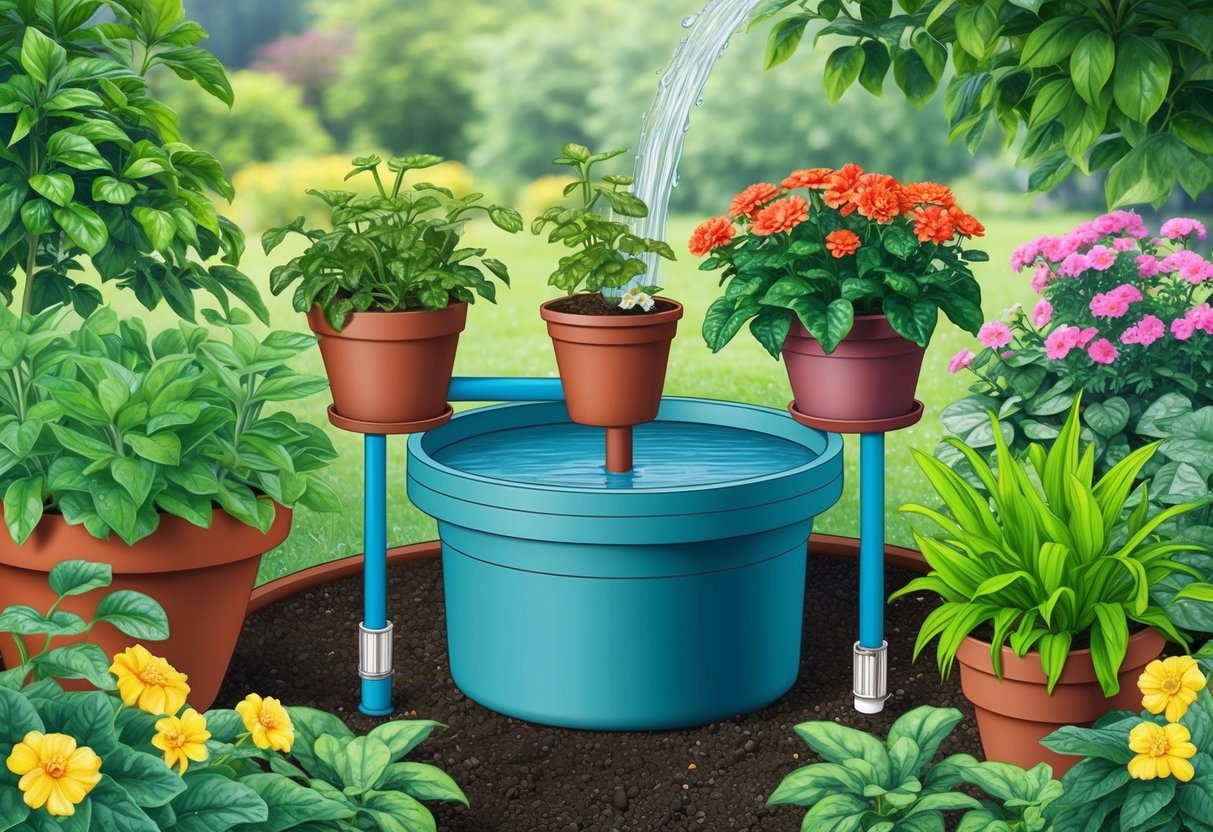
Selecting the Right Self-Watering Method
Choosing a self-watering system starts with matching garden needs, plant types, and personal maintenance preferences. The right setup reduces the risk of overwatering, promotes healthy plant growth, and can greatly simplify long-term plant care.
Choosing Between Pots and Drip Irrigation
Self-watering pots are containers with built-in reservoirs that deliver water directly to the plant roots through capillary action. These are ideal for small spaces, houseplants, or balcony gardening.
The main advantage is consistent soil moisture without daily watering, especially helpful for busy schedules or travel. Self-watering pots require less frequent attention, making them suitable for individual plants or small groups.
Drip irrigation, on the other hand, involves a network of tubes and emitters that slowly release water at the plant base. This method works well for larger gardens, raised beds, or rows of vegetables.
Drip irrigation systems can be customized to cover different plant requirements and can be expanded as needed. Unlike pots, drip irrigation provides broader coverage but usually requires more setup and regular maintenance.
Both methods efficiently reduce water use and help prevent diseases from overhead watering. For an in-depth look at self-watering containers, visit this guide to self-watering pots and planters.
Pros and Cons of Manual vs Automated Systems
Manual self-watering systems, such as basic pots with reservoirs or gravity-fed drip lines, require regular human intervention to refill water reservoirs and monitor moisture levels. They are cost-effective, easy to set up, and ideal for those who prefer hands-on garden care.
However, manual systems may not be reliable during extended absences or in larger gardens, where checking each point can become a burden. Automated self-watering setups utilize timers, sensors, or smart controllers to handle watering on a set schedule or in response to soil moisture.
These systems are suitable for gardens where consistent, unattended care is needed, such as when the gardener travels often or manages many plants. The initial investment and complexity are higher, but maintenance needs are often lower over time.
Automated drip irrigation is particularly effective in scaling up efficient watering for a bigger garden or greenhouse, ensuring plants remain healthy with minimal daily effort.
| Feature | Manual Systems | Automated Systems |
|---|---|---|
| Cost | Low | Higher |
| Maintenance | Frequent/Hands-on | Low/Occasional |
| Setup Complexity | Simple | Moderate–Complex |
| Extended Absence | Less Reliable | Highly Reliable |
Each option has unique benefits and challenges, so matching the system to the gardener’s schedule and scope is critical.
Designing Your Self-Watering Garden Layout
A well-planned self-watering garden layout reduces maintenance time and ensures that each plant receives optimal hydration. Thoughtful arrangement and sizing improve water distribution, leading to healthier growth for both indoor plants and outdoor vegetables.
Assessing Plant Requirements
Each type of plant has unique water needs. For example, leafy greens such as lettuce require more frequent moisture than drought-tolerant species like cactus.
A layout that groups plants with similar watering needs together is practical and reduces water waste. Consider the mature size of the plants to avoid overcrowding.
This also makes it easier to manage light exposure, which is crucial for gardening success. For indoor plants, factor in the amount of natural light each spot receives throughout the day.
Typical plant water needs table:
| Plant Type | Water Needs | Placement Suggestion |
|---|---|---|
| Leafy greens | High | Central/well-lit areas |
| Herbs | Moderate | Partial sun |
| Succulents/Cacti | Low | Bright, dry spots |
Test the soil mixture to ensure it’s compatible with self-watering systems. A well-draining mix is essential, especially for plants that can suffer from root rot, like succulents and certain indoor varieties.
Planning Flow and Placement
The arrangement of planters or garden beds will affect how water flows and is distributed. Place containers with higher water requirements closer to the main water reservoir or wicking source.
Raised beds, like those used in DIY self-watering systems, make managing flow easier. It helps to sketch a simple garden map that shows the placement of each planter.
Identify areas that receive at least six hours of direct sunlight, which benefits most vegetables and many indoor plants. For a balcony or limited space, vertical arrangements maximize the number of pots while still ensuring effective watering.
Ensure pathways allow easy access for monitoring water levels and plant health. Use water-safe materials—like fish-safe rubber membranes—when lining planters to prevent leaks and promote even moisture distribution.
For cactus or other low-water plants, slightly elevate their containers to encourage faster drainage and avoid oversaturation.